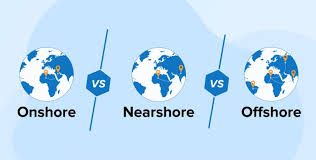Comparing Onshore, Nearshore, and Offshore IT Outsourcing Costs

In today’s globalized economy, businesses have various options when it comes to outsourcing their IT needs. Onshore, nearshore, and offshore outsourcing are three common models. Each has unique advantages and costs. Businesses must understand the differences in costs and benefits among these models. This is crucial for those looking to optimize their IT outsourcing strategies.
Nearshore outsourcing means entrusting tasks to an external agency, team, or person in a nearby country. For instance, US companies often outsource to Latin American nations, like Costa Rica. Costs there are lower but the work is still high-quality.
This approach is an alternative to having an in-house team or using the more expensive onshore outsourcing model. The onshore model involves working with professionals in the same country. Nearshore outsourcing is popular in software services. It is favored because Latin America has many software talent and its time zone matches North American clients.
What is Offshore Outsourcing?
Offshore outsourcing entails a company engaging a team situated in a distant country to fulfill tasks or projects on their behalf. This arrangement often involves collaborating with an offshore company or freelancers. They provide services the company either lacks the capacity or preference to manage internally.
For instance, a US-based company might partner with one in the Philippines or India. The main reason for this decision is usually cost savings. Teams in remote places tend to offer services at lower rates.
However, offshore partnerships have big challenges. For example, there are large time zone and cultural differences. These can complicate communication and collaboration. Despite these obstacles, many businesses find that the cost advantages outweigh the additional complexities.
Onshore Outsourcing: Proximity Comes at a Price
Cost Factors
- Labor Costs. Onshore outsourcing involves hiring resources within the same country or region as the client company. This closeness may lead to better communication and cultural alignment. But, it often comes with higher labor costs. These are due to factors like local wages and overhead.
- Regulatory Compliance. Onshore outsourcing can ease compliance with local laws and data protection. But, it may also have higher compliance costs than other models.
Advantages
- Proximity and Communication. Onshore outsourcing facilitates easier communication and collaboration, reducing the risk of misunderstandings and delays.
- Cultural Compatibility. Similar cultures can foster better understanding. This helps align the client and outsourcing team.
Nearshore Outsourcing: Balancing Cost and Proximity
Cost Factors
- Labor Arbitrage. Nearshore outsourcing involves contracting with nearby companies. They are in neighboring or nearby countries. It offers a balance between cost savings and proximity. Labor costs in these regions may be lower than in the client’s home country but higher than in offshore destinations.
- Travel Expenses. While closer in proximity compared to offshore outsourcing, nearshore engagements may still incur travel expenses for onsite meetings and collaboration.
Advantages
- Cost Efficiency. Nearshore outsourcing offers cost savings compared to onshore alternatives while maintaining close geographic and time zone alignment.
- Cultural Affinity. Nearshore teams often share similar time zones and cultural norms, facilitating smoother collaboration.
Offshore Outsourcing: Cost-Effective Global Solutions
Cost Factors
- Labor Cost Arbitrage. Offshore outsourcing involves contracting with companies in distant countries, often characterized by lower labor costs compared to onshore and nearshore options.
- Time Zone Differences. Offshore outsourcing may present challenges related to time zone differences, requiring adjustments in communication and project management approaches.
Advantages
- Cost Savings. Offshore outsourcing offers the most significant potential for cost savings, making it an attractive option for businesses seeking to optimize their IT budgets.
- Access to a vast talent pool in offshore locations allows for scalable solutions tailored to specific project requirements.
Comparison Table
| Aspect | Nearshore Outsourcing | Offshore Outsourcing | Aspect |
| Real-time collaboration | Same or similar time zone | 5-12 hour time zone difference | Real-time collaboration |
| Cultural affinity | Very similar work culture and practice | Not as similar | Cultural affinity |
| English language proficiency | Moderate to low proficiency across Latin America | Wide range from Very Low to High across Europe and Asia | English language proficiency |
| Travel accessibility | 2-5 hour flights, less complicated than traveling to Europe or Asia | 8+ hour flights, plus an increased need for overnight accommodations | Travel accessibility |
| Project security | Increased likelihood of shared or similar data protection laws | Not likely to share data protection laws | Project security |
| Cost savings | Not as pricey as Onshore | Affordable but hard to manage | Cost savings |
Choosing Between Nearshore and Offshore: Factors to Consider
When choosing between nearshore and offshore outsourcing, you must consider:
- Your Project Requirements.Each project has its own requirements. These may include specialized skills, specific technology stacks, or preferred development methods. It’s crucial to analyze the specifics of your project to determine which outsourcing model can provide the expertise and resources best suited to meet your project’s needs.
- Your Budget Constraints.Budget considerations often play a pivotal role in outsourcing decisions. While offshore outsourcing may offer cost-saving benefits, nearshore outsourcing might deliver better long-term value. Assess your financial flexibility. Align it with the pricing structures of each outsourcing model. This will help you make a viable choice. It will meet your project’s requirements without compromising quality.
- Your Cultural Compatibility.Effective communication and cultural alignment are vital for the success of any project. If you need real-time collaboration and few cultural barriers, nearshore outsourcing could be better for you. But, if these aspects are less important than cost savings, offshore outsourcing might offer more advantages. It would be in terms of money and resources.
Conclusion
When comparing onshore, nearshore, and offshore IT outsourcing costs, businesses must think carefully. They must consider their priorities and objectives. Onshore outsourcing offers proximity and cultural alignment. But, it often has higher costs. Nearshore outsourcing balances cost and closeness. Offshore outsourcing saves money but requires more effort to manage communication and coordination well.





